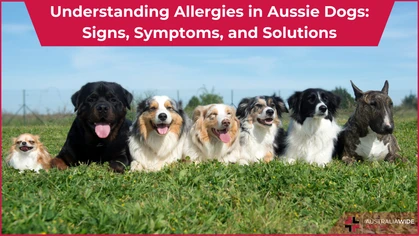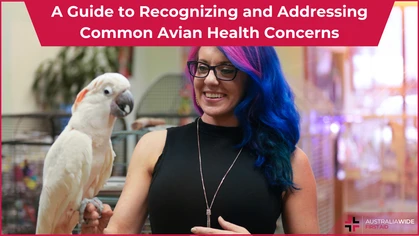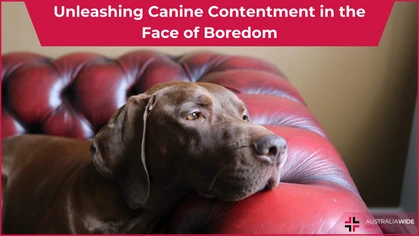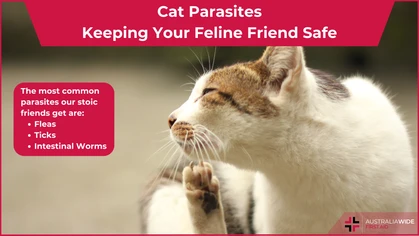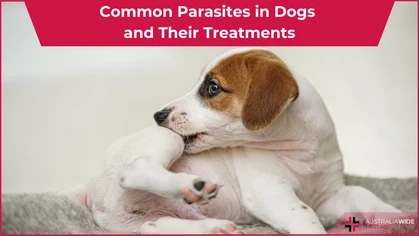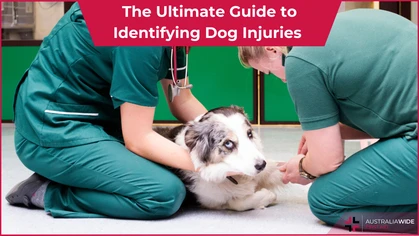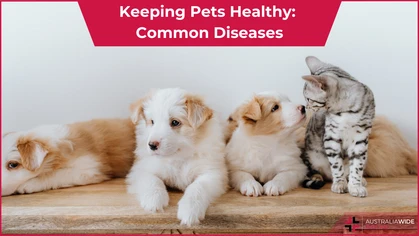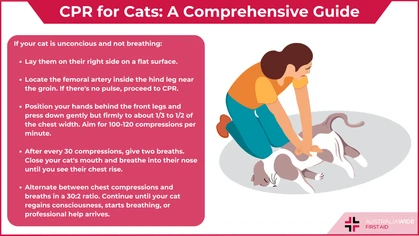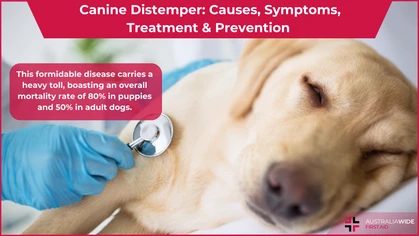Canine Parvovirus: Causes, Symptoms, Treatment & Prevention

Pets
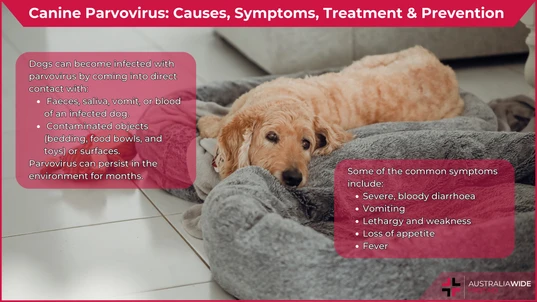 In the tapestry of canine well-being, a subtle but potentially devastating threat looms known as canine parvovirus. Despite a vaccine being a shield against this menace, the lack of awareness among pet owners often leaves dogs vulnerable.
The scariest part is parvo can live in the environment for up to a year, so even a quick trip to the vet or pet store could expose your dog. Is your dog safe from this invisible threat? Learn how to protect your pup from parvo and spot the signs of infection.
In the tapestry of canine well-being, a subtle but potentially devastating threat looms known as canine parvovirus. Despite a vaccine being a shield against this menace, the lack of awareness among pet owners often leaves dogs vulnerable.
The scariest part is parvo can live in the environment for up to a year, so even a quick trip to the vet or pet store could expose your dog. Is your dog safe from this invisible threat? Learn how to protect your pup from parvo and spot the signs of infection.
What is Canine Parvovirus?
Canine parvovirus (CPV) is a highly contagious viral disease that targets dogs, particularly impacting the gastrointestinal tract through contact with contaminated faeces. Puppies and unvaccinated dogs aged six weeks to six months are at the greatest risk. The virus can persist in the environment for months, making canine parvovirus prevention through vaccination crucial. Puppies should receive their first doses at six, eight, and twelve weeks to build immunity, with additional booster shots required for continued protection.Outbreaks of Canine Parvovirus in Australia
Past canine parvovirus outbreaks in Australia have left a trail of devastation. The initial outbreak in 1978 swept rapidly across the United States, Europe, Australia, and Asia, carrying a significant case fatality rate and causing severe consequences. According to a study conducted in 2017, the estimated national incidence of canine parvovirus (CPV) was calculated at 4.12 cases per 1000 dogs. The study analysed 4219 CPV case reports and projected an annual 20,110 cases.How Does Parvo Spread Between Dogs?
Dogs can become infected with parvovirus by coming into direct contact with the faeces, saliva, vomit, or blood of an infected dog. Dogs can get infected indirectly by contact with contaminated objects (bedding, food bowls, and toys) or surfaces. Parvovirus can persist in the environment for months, posing a risk when dogs encounter contaminated areas like grass, dirt, or concrete.Signs and Symptoms of Parvo in Dogs
The signs of parvo in dogs can vary depending on the severity of the infection, but some of the common symptoms include:- Severe, Bloody Diarrhoea - Parvo attacks the intestines, causing inflammation and sloughing of the intestinal lining. This results in foul-smelling, watery stools with blood.
- Vomiting - Dogs will throw up undigested food due to the virus attacking the stomach and upper intestines. They may also dry heave when the stomach is empty.
- Lethargy and Weakness - Parvo causes dehydration, malnutrition, and sepsis, leaving dogs extremely ill and tired. Parvo in puppies makes them very weak and unable to stand.
- Loss of Appetite - Nausea, stomach pain, and feeling ill from parvo will cause dogs to refuse food and water. This worsens dehydration and malnutrition.
- Fever - Dogs often have a high fever, up to 104-106°F. The fever occurs as the body attempts to fight the viral infection.
Diagnostic Methods Used to Confirm the Parvovirus
Several diagnostic methods are employed to confirm the presence of parvo in dogs, including:- Fecal ELISA Test - The fecal ELISA test, a common and affordable diagnostic method, is non-invasive and widely available at veterinary clinics. By examining a fecal sample for parvovirus antigens, a positive result confirms your dog's infection with parvovirus.
- PCR Test - The PCR test, though pricier than the fecal antigen test, is more accurate. It examines blood, feces, or saliva for parvovirus DNA, and a positive result confirms your dog's infection with parvovirus.
- X-ray or Ultrasound - Veterinarians may suggest an X-ray or ultrasound of your dog's abdomen to gauge infection severity and spot complications like intestinal obstruction or peritonitis.
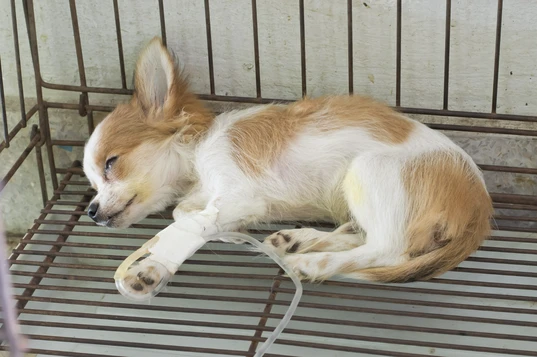
Puppies can become seriously ill very quickly.
Treating a Dog with Parvovirus
When treating parvo in dogs, there is no specific cure available. However, canine parvovirus treatment focuses on providing supportive care to aid the dog's body in fighting off the infection. Early and intensive treatment, initiated within the first 48-72 hours of symptoms, significantly improves the prognosis for recovery. Measures may include:- Intravenous fluids: Since parvovirus causes dehydration, it is crucial to administer intravenous fluids to replenish the dog's lost fluids and electrolytes.
- Antibiotics: Dogs with parvovirus are prone to developing secondary bacterial infections. To prevent this, antibiotics may be prescribed as a preventive measure.
- Anti-nausea medication: Vomiting can exacerbate dehydration in dogs with parvovirus. Therefore, anti-nausea medication may be administered to reduce vomiting and further minimize dehydration.
Parvovirus in Dogs Home Treatment
Here are some guidelines to consider when caring for a dog with parvovirus at home. These tips will help ensure your furry friend receives the best care:- Keep your dog well-hydrated by offering him small amounts of water or Pedialyte frequently throughout the day.
- Provide your dog with a bland diet consisting of boiled chicken and rice, serving it in small and frequent meals.
- Pay close attention to signs of complications such as vomiting, diarrhea, or lethargy. It's essential to monitor your dog's condition closely.
- Isolate your dog from other dogs and people to prevent the canine parvovirus infection from spreading further.
- Thoroughly clean and disinfect all surfaces that your dog has come into contact with using a bleach solution (1 part bleach to 30 parts water).
- Properly dispose of your dog's faeces immediately after defecation.
Importance of Vaccination in Preventing the Virus
Vaccines function by introducing a weakened or inactivated form of the virus to your dog's immune system. This prompts the development of antibodies, protecting against future exposure to the virus. The World Small Animal Veterinary Association (WSAVA) advise that puppies under 16 weeks get their initial parvovirus vaccination at 6-8 weeks, with boosters every 2-4 weeks until 16 weeks old. Parvovirus vaccination frequency varies (every 1-3 years) for adult dogs, depending on the canine parvovirus vaccine type. Dogs at high risk, like those often boarded or frequenting dog parks, may need more frequent vaccinations for optimal protection. Consult your vet to determine the appropriate vaccination schedule for your area. Ensuring all dogs receive vaccinations is crucial to curbing the virus's spread in the community. By prioritizing your dog's vaccination, you actively contribute to your pet's and others' safety.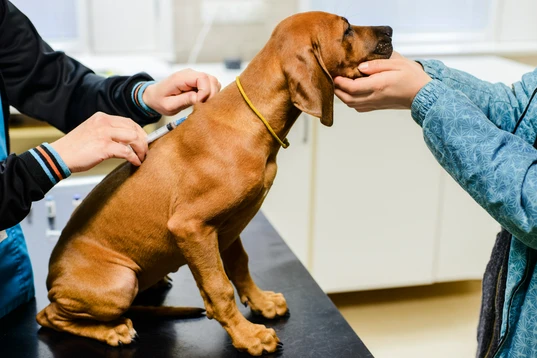
Keeping your puppy up to date with their vaccinations gives them a better layer of protection.
Canine Parvovirus Survival Rate
The survival rate of canine parvovirus depends on factors like infection severity, the dog's age and health, and the quality of treatment. Upon proper treatment, the canine parvovirus survival rate is around 80-90%. Puppies and dogs with existing health issues face higher risks. Early diagnosis and immediate veterinary care are crucial for improving CPV survival rates.How Long Should a Dog With Parvo Be Isolated?
When managing a dog with parvovirus, adhering to specific guidelines is imperative. Once all visible signs of the virus have subsided, isolating the dog for at least two weeks is advisable. This precaution is vital because, even after apparent recovery, the virus may persist in the dog's faeces for up to ten days.Can Humans Get Canine Parvovirus?
While canine parvovirus is highly contagious among dogs, the good news is that humans can't catch the CPV-2 strain that affects canines—it's strictly a doggy affair. However, it's still wise to maintain good hygiene. After all, who doesn't appreciate clean hands? Wash up after any dog contact, especially if they're under the weather. Also, give their food bowls, bedding, and floor mats a good scrub. Diluted bleach works wonders and zaps the parvovirus on surfaces. If someone in your home has a weakened immune system, limiting contact with the infected pup is best. Parvovirus can be a persistent foe, so let's keep it from jumping between pets in the same household. Isolating the sick dog and practicing good hygiene is the name of the game.Conclusion
Are you doing everything you can to protect your furry friend from parvovirus? Your pup's health should be a top priority, and one crucial way to safeguard them is by keeping their vaccinations up to date. Diseases like canine parvovirus can be prevented, sparing you from hefty vet bills and heartbreak. Take action today to shield your best friend from this preventable disease; their life depends on it.FAQs
How Do Dogs Get Parvo From the Ground? Dogs can contract parvo through activities like sniffing, licking, or consuming infected faeces on the ground. Parvovirus can persist in diverse environments, including parks, yards, kennels, and other areas where dogs congregate, even in extreme temperatures. Can a Vaccinated Dog Get Parvo? Yes! While it's rare, even a vaccinated dog can contract parvo, although the likelihood is significantly lower compared to an unvaccinated dog. Parvovirus vaccination is highly effective, though not 100%. There's a small chance a vaccinated dog may still get infected, especially if exposed to a high dose of the virus. How Long Can Parvo Live on Human Skin? Parvovirus can survive on human skin for up to 24 hours. It's crucial to wash your hands thoroughly with soap and water after handling a dog or its faeces.
Originally published at
https://www.australiawidefirstaid.com.au/resources/canine-parvovirus
as part of the Australia Wide First Aid Articles Library
